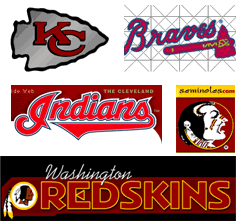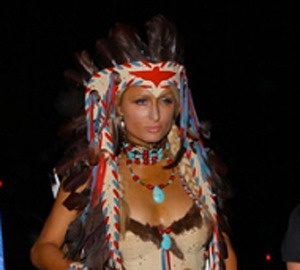Erasing the White Man's Indian: Stereotypes of Native Americans
The Stereotyping of the Native American Indian in the United
States seems to be as American as Baseball or Apple Pie. The negative labeling of our indigenous people
is almost as prevalent as the common cold and has been going on longer than the
United States of America has been a country. The Stereotypes are everywhere in our culture. They help sell all sorts products and promote many different types of sports teams. The misrepresentations are
in our movies, T.V. shows, pop songs, comic books and have even made their way
into our history lessons. The false portrayal
of Native Americans is an institution in the United States that has a long history and if things continue as they have been, they will have a long future.
Jane McCrea was a 26 year old victim of the Revolutionary
war (Jane 1). She was captured by Native
Americans that were allied to the British Crown (Jane 1). She was scalped supposedly by those same captors (Jane 1) The British paid hefty bounties for the scalps of enemies of the crown (See March 23, 2013 Post). The Rebel Colonists embellished the details of her untimely demise and then spread the story in newspapers throughout the colonies (Jane 1). This anti-British propaganda also spread hatred and fear of all Native Americans in the American colonies (Jane 1). A depiction of Jane’s death was painted by John Vanderlyn in
1804 and the painting helped perpetuate the misrepresentation of “The Skulking
Indian Enemy”.
The Death of Jane McCrea
Newspapers in America have been
instrumental in protecting our democracy from the lies of tyrants and seeking
out the truth by developing a tradition of journalistic ethics. Unfortunately, that has not always been the
case. Newspapers and reporters have also
been guilty of misleading the public or even spreading lies about Indian attacks
on defenseless white settlers to sell more newspapers and thus helped to perpetuate the myth of, “The
Skulking Indian Enemy” (Lester 113).
This stereotype takes on many forms most commonly the painted face, war
crying savage attacking innocent woman and children (Lester 114). This is the most recognizable Indian to most
of the world due to the movie industry pumping out one flick after another
portraying the Native American in this way.
(A short documentary on Hollywood's treatment of Native Americans)
Many of Americas young children in this country were introduced to stereotypes of Native Americans through cartoons.
(Short "Betty Boop" cartoon from the late 1930's)
(See I told you Native Americans can be funny too!)
The stereotypes of the “Skulking Indian Enemy”, and “The Noble Savage”,
are the most common misrepresentations used by sports teams (Lester 115). Teams like the Braves, the fighting Illini of
the University of Illinois, and Sioux of the University of North Dakota rely on
the fear that the “Skulking Indian Enemy” social construct might conjure in the minds of their opponents
( 115) However, some sports teams like
the Cleveland Indians have chosen a composite of the two stereotypes. The Cleveland Indians mascot is “Chief Wahoo”
a cartoonish caricature that also exaggerates the racial features that Native
Americans are often associated with. The
most blatantly racist team name has to be the Redskins best known as the
professional football team representing Washington D.C. Fans of these teams make war cries, wave toy
tomahawks, do war dances dressed as Indians, and threaten to scalp their rivals
(115). Team owners and fans defend these
names and mascots by saying that they are respecting and honoring Native Americans. In all fairness there are some teams like the
University of Florida Seminoles that have been given permission by the tribe to
use their name and image (115). Still it is
hard to imagine most Native Americans are not offended by the way they are
portrayed at these sporting events.
Today, many schools have decided to either change the name of their team
or if the tribe still exists ask for permission to use their likenesses in a respectable
manner (116). The stereotypes of the "Skulking Indian Enemy”, and, “The Noble Savage”, usually seek to dehumanize the male Native American. Native American women have a different set of negative labels to overcome.
Native American women have for a long time been referred to collectively as "Squaws". Native American woman did not refer to themselves as such the name was pinned on them and it stuck. The term "Squaw" in popular American culture has two different derogatory meanings (scholarsbank
1). The two primary definitions for a "Squaw" in our culture are first as a sexual punching bag and then as a drudge (1). Whites pushed the idea of the "Squaw" being a drudge or workhorse because the concept not only dehumanized them but was the direct opposite of what the ideal white woman was supposed to be this providing evidence of their savagery (Smits 1). The Indian "Squaw" as a sexual object degrades Native American women and shows them as being an object for men, primarily white, to possess and manipulate (Ardrey 1). The media markets this look to women and makes the stereotype a norm in society (1). This type of stereotyping reinforces public impressions of what
constitutes female Indian-ness and the place of indigenous women in a
simultaneously romanticized and demonized past, present and future (1). It is time for the
squaw to be liberated and no longer the property of Native or non-Native American
men. Some stereotypes can apply to either Native American men or women. The “Drunken Indian” social construct of Native Americans is completely gender neutral
.
.
.jpg)
The myth of the “Drunken Indian” assumes that all Indians are
powerless over alcohol and that despite the noble efforts of the U.S.
government the Native American is doomed to be a hopeless drunkard because of
the loss of the tribal way of life (Miller 226). There is no doubt that there are alcohol
problems among Native Americans. There
are alcohol problems among all races of people. Ironically, Native American treatment programs
have demonstrated a high success rate especially among the youth (228). It has
been theorized that alcohol was not known to Native Americans and therefore they
did not develop the proper genes needed to process alcohol (229). Alcohol was indeed known to many tribes
before European contact although they probably did not consume it other than in
a ceremonial manner (229). Rather than
some biological reason for Indian Alcoholism researchers point to deplorable
economic and social conditions on reservations and Indians living in urban
areas as the leading cause of Native American alcohol abuse. The U.S. federal government bears a large responsibility
for the dissemination of the “Drunken Indian” myth (235). If the Native American is perceived as
helpless then they may need a benevolent “Father” figure that is really a wolf
in disguise. Just like all other stereotypes
the “Drunken Indian” is totally false yet still widely believed.
(A brief news report about poverty on the "Pine Ridge" Reservation)
I will leave you with a poem that one of my Native American sisters wrote and was published in Aloud: Voices of the Nuyorican Poets Cafe.
Sure You can Ask me a Personal Question
by Diane Burns
How do you do?
No, I'm not Chinese.
No, not Spanish.
No, I'm American Indi..uh, Native American.
No, not from India.
No, we're not extinct.
No, not Navajo.
No, not Sioux.
Yes, Indian.
Oh, so you've had an Indian friend?
That close.
Oh, so you had an Indian lover?
That tight.
Oh, so you've had an Indian servant?
That much.
Oh, so that's where you got those high cheek bones.
Your great-grandmother, eh?
Hair down to there?
Let me guess...Cherokee?
Oh, an Indian Princess.
No, I didn't make it rain tonight.
No, I don't know where you can get Navajo rugs real cheap.
No, I don't know where you can get peyote.
No, I didn't make this... I bought it at Bloomingdale's.
Yes, some of us drink to much.
Some of us can't drink enough.
This ain't no stoic look.
This is my face.
There are many more stereotypes about Native Americans than could ever
fit into this Blog. I have selected
those that are the most pervasive and still widely believed. All of these negative labels share a central
theme. The idea has always been to
dehumanize and make it more socially acceptable to treat Native Americans with
less respect and dignity than people of all other races and especially the
white race. What separates the longstanding
negative social construct of the Native American from all of the other American
ethnic and racial minorities constructs is that their negative labels helped to
inspire the greatest genocide the world has ever known.
I will leave you with a poem that one of my Native American sisters wrote and was published in Aloud: Voices of the Nuyorican Poets Cafe.
Sure You can Ask me a Personal Question
by Diane Burns
How do you do?
No, I'm not Chinese.
No, not Spanish.
No, I'm American Indi..uh, Native American.
No, not from India.
No, we're not extinct.
No, not Navajo.
No, not Sioux.
Yes, Indian.
Oh, so you've had an Indian friend?
That close.
Oh, so you had an Indian lover?
That tight.
Oh, so you've had an Indian servant?
That much.
Oh, so that's where you got those high cheek bones.
Your great-grandmother, eh?
Hair down to there?
Let me guess...Cherokee?
Oh, an Indian Princess.
No, I didn't make it rain tonight.
No, I don't know where you can get Navajo rugs real cheap.
No, I don't know where you can get peyote.
No, I didn't make this... I bought it at Bloomingdale's.
Yes, some of us drink to much.
Some of us can't drink enough.
This ain't no stoic look.
This is my face.
References
Algarín, M., & Holman, B. (1994). Aloud: Voices from the Nuyorican Poets Cafe. New York: H. Holt.
Ardrey, K. (2011). hpiamardrey. Hofstra People. Retrieved March 29, 2013, from http://people.hofstra.edu/daniel_m_varisco/hpiaardrey.html
Smits, D. D. (1982). The "Squaw Drudge": A Prime Index of Savagism. Ethnohistory, 29(4), 281-306.
Ardrey, K. (2011). hpiamardrey. Hofstra People. Retrieved March 29, 2013, from http://people.hofstra.edu/daniel_m_varisco/hpiaardrey.html
Smits, D. D. (1982). The "Squaw Drudge": A Prime Index of Savagism. Ethnohistory, 29(4), 281-306.
Jane McCrea Notable Women Ancestors. (n.d.). Retrieved from http://www.rootsweb.ancestry.com/~nwa/jane.html
Lester, P. M. (2011). Images That Injure: Pictorial Stereotypes in the Media, Third Edition. Santa Barbara: ABC-CLIO.
Retrieved from https://scholarsbank.uoregon.edu/xmlui/bitstream/handle/1794/11739/s-word.pdf?sequence=1
The 'Drunken Indian:' Myth Distilled into Reality Through Federal Indian Alcohol Policy by Robert Miller, Maril Hazlett :: SSRN. (n.d.). Retrieved from http://papers.ssrn.com/sol3/papers.cfm?abstract_id=1160478


.jpg)
.jpg)
.jpg)

.jpg)


.jpg)
Pocahontas was one of my favorite movies as a child, it is a great memory of my childhood, however I could see how it distorts the way things were. In my mind though it was a beautiful depiction of something I knew nothing about as a child. Good post!
ReplyDeleteSo much information, so much to think about, some great graphics and references.
ReplyDelete